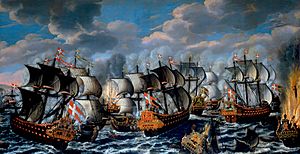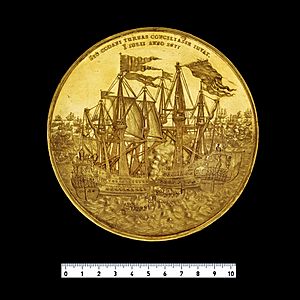Battle of Køge Bay (1677) facts for kids
Quick facts for kids Battle of Køge Bay |
|||||||
|---|---|---|---|---|---|---|---|
| Part of the Scanian War | |||||||
 Battle of Køge Bay by Claus Møinichen |
|||||||
|
|||||||
| Belligerents | |||||||
| Commanders and leaders | |||||||
| Strength | |||||||
| 34 ships 6,700 men |
45–47 ships 9,200 men |
||||||
| Casualties and losses | |||||||
| ca. 275 wounded & 100 dead | 20 ships ca. 3,000 wounded, captured & dead |
||||||
The Battle of Køge Bay was a huge naval battle between Denmark-Norway and Sweden. It happened in the bay near Køge from July 1 to 2, 1677. This battle was part of a bigger conflict called the Scanian War.
The Danish-Norwegian fleet, led by Admiral Niels Juel, won a major victory. Many people see this as the greatest naval win in Danish history!
Contents
Why did the Battle of Køge Bay happen?
The Scanian War and Control of the Sea
The Battle of Køge Bay was part of the Scanian War (1675–1679). This war involved Denmark, Norway, Sweden, and other European countries. Denmark and its allies were fighting Sweden.
Sweden needed to send supplies and soldiers to its lands in northern Germany. But the Danish fleet was blocking the way. In 1676, the Danish navy had already beaten the Swedish navy badly at the Battle of Öland. Sweden lost three of its biggest ships and important admirals. This meant Denmark controlled the Baltic Sea for a while.
Denmark used this control to send a large army to Skåne (a region in southern Sweden). This brought the war right to Swedish land.
On land, the Swedish army, led by King Charles XI, started to win some battles. They won at Halmstad and Lund in late 1676. The Danish army had to retreat.
Both sides desperately needed to control the sea. Denmark needed to resupply its army in Skåne. Sweden needed to send help to its lands in Germany. A big naval battle was coming!
Fleet Strengths and Weaknesses
Even after their defeat, the Swedish navy still had more ships than the Danish navy in early 1677. But they had big problems. They struggled to get enough supplies, equipment, and sailors for their ships.
The Danish fleet, on the other hand, had many skilled and experienced officers. This gave them a big advantage. Henrik Horn became the new commander of the Swedish navy in March 1677. But he had no experience leading ships in battle. This was a major disadvantage for Sweden.
Before the main battle, a smaller Swedish squadron tried to join Horn's fleet. But a stronger Danish force attacked them at the battle of Møn. The Danes won, sinking or capturing many Swedish ships. This made the Swedish navy even weaker.
Getting Ready for Battle
After his victory at Møn, Admiral Juel repaired his ships. He sent out smaller ships to scout for the Swedish fleet. On June 17, he learned that Sweden planned to move soldiers from Germany to Skåne.
Juel's scouts soon reported seeing a large Swedish fleet. It had about 30 warships and 15 supply ships. The Danish leaders debated whether to fight right away or wait for more ships from their Dutch allies. King Christian V even ordered Juel to avoid battle.
But Juel was confident. He believed his experienced fleet could win, even against a larger Swedish force.
The main Swedish fleet left its base near Stockholm on June 9. Admiral Horn spent almost two weeks training his crews. Finally, on June 30, the two huge fleets spotted each other between Stevns Klint (a cliff in Denmark) and Falsterbo (in Sweden).
The Battle of Køge Bay Begins
The battle started on the night of June 30. One Swedish ship, the S:t Hieronymus, got stuck in the mud and couldn't join the fight.
On July 1, both fleets formed long lines, ready for battle. The Swedish fleet had more ships. Admiral Horn tried to sail west to cut off the Danes from their bases. As they sailed, the ships fired their cannons at each other.
During this time, a Swedish ship called Draken (the Dragon) ran aground near Stevns Klint. Several Danish ships, including Juel's own flagship Christianus V, fired heavily at it. The Draken was badly damaged and had to surrender. Juel's flagship was also damaged, and he had to move his flag to other ships during the battle.
Juel's Bold Move
Around midday, a thick fog of gunpowder smoke covered the sea. The Swedish admiral, Horn, thought he saw Dutch reinforcements arriving. He decided to split his fleet to avoid what he thought was a stronger enemy.
But what Horn saw was actually a part of the Danish fleet that had moved forward. Juel saw Horn's mistake. Instead of just sailing parallel to the Swedish line, Juel made a very bold move. He turned his ships to cut right through the middle of the Swedish line!
This move trapped a part of the Swedish fleet, led by Clerck. They were now caught between two groups of Danish ships, getting fired at from both sides. Horn tried to help Clerck's ships, and a fierce cannon fight began. But the Swedish fleet was outmaneuvered. Two large Swedish warships, the Mars and the Caesar, were captured by the Danes.
What Happened After the Battle?
The Battle of Køge Bay was a huge win for Denmark and a big defeat for Sweden. Denmark lost only about 100 men and no ships. Sweden, however, lost six large warships, several smaller ships, and about 3,000 men (killed, wounded, or captured).
This victory gave Denmark-Norway full control of the Baltic Sea. This meant Sweden could no longer easily send supplies or soldiers to its lands in Germany. The Danish-Dutch fleet even raided parts of Sweden's coast.
For the rest of the Scanian War, Denmark completely ruled the seas. The Swedish fleet avoided more battles. Sweden could no longer supply its troops in Germany, and they eventually surrendered.
Admiral Juel's decision to cut through the Swedish line has been talked about a lot by historians. Some historians in the 1800s thought Juel invented a new naval tactic called "breaking the line". They believed he did this a century before famous admirals like George Rodney used it.
However, more recent historians say that naval officers knew about the idea of breaking the enemy's line. But it was very hard to do back then because ships and crews weren't disciplined enough. So, while Juel's move was brilliant, it might not have been a completely new invention.
Who Fought in the Battle?
The Swedish fleet had more ships, cannons, and men. They had 30 large warships, 6 fireships, and 11 support ships. In total, they had about 1,650 cannons and 9,200 men.
The Danish fleet had 35 warships, 2 fireships, and 7 support ships. They had about 1,400 cannons and 6,700 men.
Even though Sweden had more ships, some of their ships were not built for war. They were armed merchant ships. The Danish fleet had better leaders and more experienced crews. This gave them a big advantage.
(The numbers in parentheses show how many cannons each ship had.) A Fireship was a regular ship filled with flammable materials. It was set on fire and sent towards enemy ships to burn them or make them scatter.
Danish Fleet1st Squadron
2nd Squadron
3rd Squadron
|
Swedish Fleet1st Squadron
2nd Squadron
3rd Squadron
"Joined Later in the Battle"
|



